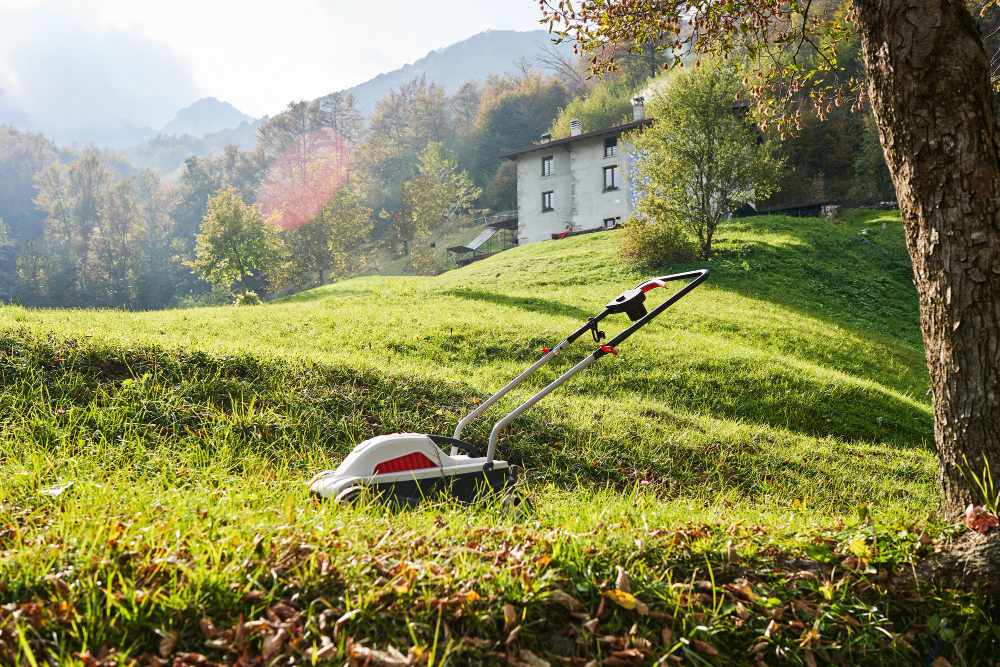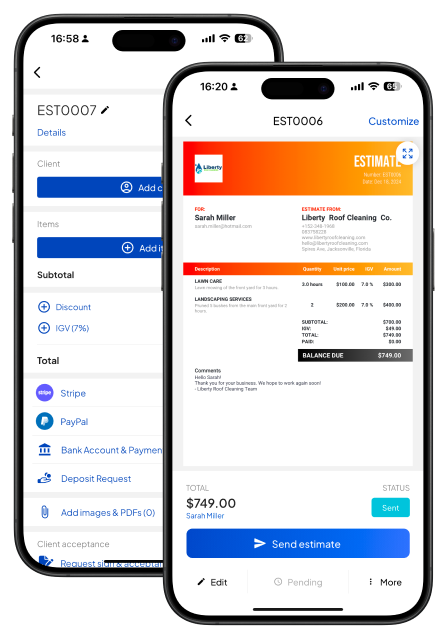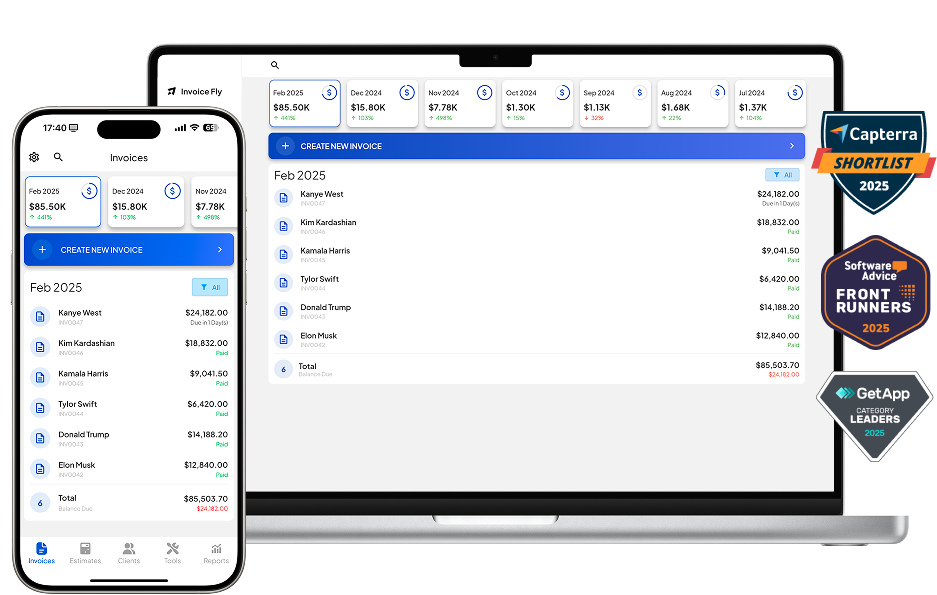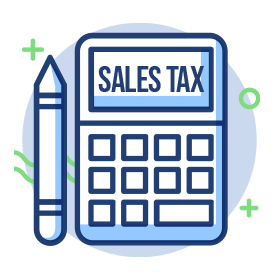- Home
- »
- Free Resources for Small Businesses
- »
- Free Business Calculators
- »
- Lawn Care Cost Calculator
Lawn Care Cost Calculator
Keeping your yard looking its best shouldn’t mean guessing at your bill. In this updated July 2025 guide, we’ll walk you through how pros arrive at their mowing rates, offer fresh average figures, and explain what really drives your lawn care expenses.

Estimated Job Cost
How to use Invoice Fly's free lawn care cost calculator:
Table of Contents
What does this lawn care cost calculator do?
This free & online lawn care calculator gives you the estimate prices for lawn care services in the United States (updated in July 2025).
These are the available services for our lawn care cost calculator:
- Lawn mowing
- Lawn Aeration
- Dethatching
- Fertilization
- Mulch Clean Up
- Seeding
- Leaf removal
- Yard cleanup
- Weed control
With this information, you can quickly price your lawn care services and send a fast estimate or invoice to your customers.
Our goal is to make the estimating process easier so you can get paid faster and remove the hassle from your invoicing workflow.

What formula does the calculator use to get the prices?
1. Enter your lawn size
- Square Feet or Acres: You can specify your yard’s area in either square feet or acres. If you enter acres, the tool converts it to square feet (1 acre = 43,560 sq ft) to standardize all subsequent calculations.
- You Select Which Services You Need: The calculator offers a menu of common lawn‑care services, each measured per unit area or as a flat fee:
- Lawn Mowing (per sq ft)
- Aeration (per sq ft)
- Dethatching (per sq ft)
- Fertilization (per sq ft)
- Mulch application (per sq ft)
- Cleanup (flat or per area)
- Seeding (per sq ft)
- Leaf Removal (flat or per area)
- Yard Cleanup (flat or per area)
- Weed Control (flat or per area)
- The Tool Applies Industry‑Standard Unit Rates: For each selected service, the calculator multiplies the lawn area by two embedded rates—a minimum and maximum price per unit—reflecting regional and labor/equipment cost variations. For example:
- Cost_min(mow) = area_sqft × rate_min_mowing
- Cost_max(mow) = area_sqft × rate_max_mowing
- This yields a low–high cost estimate for every service line item.
- It Sums Up All Service Costs: The calculator aggregates each service’s min and max costs to produce an overall range:
- Total_min = Σ Cost_min(service_i)
- Total_max = Σ Cost_max(service_i)
- This ensures you see both a conservative and a more comprehensive pricing bound before any discounts.
- Optional Discount Adjustment: If you enter a discount percentage, the tool applies it uniformly across both ends of the range:
- Final_min = Total_min × (1 – discount%)
- Final_max = Total_max × (1 – discount%)
- You immediately see your discounted cost window, helping you quote promotional or loyalty pricing
How do I improve my profit margin?
1. Know Your True Costs
Calculate Your Baseline Margin:
- Itemize all costs: Labor (wages, taxes, benefits), fuel, equipment maintenance, materials (fertilizer, seed, mulch), insurance, marketing, and administrative overhead.
- Use a cost calculator (like Invoice Fly’s Lawn Care Cost Calculator) to estimate per‑job expenses accurately.
- Compute your margin: Profit Margin = (Revenue – Total Cost) ÷ Revenue
2. Optimize Pricing and Packages
Implement Tiered Service Levels:
- Basic vs. Premium: Offer a simple mowing/cleanup package alongside a full “lawn health” bundle (aeration, fertilization, weed control).
- Contract Pricing: Sell 6- or 12-month service contracts at a slight discount versus one-off pricing—ensures predictable revenue and client loyalty.
Value-Based Pricing:
- Price according to the value you deliver (a lush, weed-free lawn) rather than just time or materials. Clients will pay a premium for guaranteed results.
3. Reduce Variable Costs
Fuel and Route Efficiency:
- Route planning software minimizes drive time and fuel consumption by clustering jobs geographically and optimizing daily schedules.
- Regular vehicle maintenance avoids costly breakdowns and keeps fuel efficiency high.
Bulk Purchasing:
- Materials: Buy fertilizer, seed, and mulch in bulk (or through wholesale co-ops) to lower per-unit costs.
- Supplies: Standardize on a few reliable brands to negotiate volume discounts.

4. Boost Labor Productivity
Standardize Processes:
- Create checklists for each service to ensure teams work consistently and efficiently.
- Cross-train staff so everyone can handle mowing, edging, cleanup, and simple equipment repairs.
Incentivize Performance:
- Offer bonuses or profit-sharing for teams that finish jobs under budgeted time without quality trade-offs.
5. Upsell and Cross‑Sell
- Add-on Services: Leaf removal, gutter cleaning, pest control, holiday lighting install.
- Seasonal Promotions: Early-spring aeration/fertilization packages or late-fall winter-prep bundles.
- Referral Discounts: Give existing clients a discount for referring new customers.
6. Leverage Technology
- Automated Invoicing: Use an invoice generator to send professional, branded invoices immediately after each job—reducing late payments and administrative overhead.
- Online Payments: Offer credit-card, ACH, or mobile-pay options to accelerate cash flow.
7. Monitor and Adjust
- Track KPIs: Revenue per job, cost per job, average ticket size, customer acquisition cost, and customer lifetime value.
- Regular Reviews: Monthly or quarterly financial check-ins to spot profit leaks early and pivot strategies.
Factors that affect lawn care pricing
Property Size Categories
Professional crews typically segment residential lawns into three bands based on acreage rather than just square feet. As of mid-2025:
- Small Yards: up to 8,000 sq ft (around 0.18 acres)
- Medium Yards: 8,000 – 14,000 sq ft (about 0.32 acres)
- Large Yards: 14,000 – 24,000 sq ft (roughly 0.55 acres)
By grouping properties this way, lawn services can match the right mower and crew size to your space.
Service Frequency Options
Your needs may shift with the seasons. Mowing once for a special event carries a premium per visit, whereas regular scheduling unlocks lower per-cut rates. Common cadence choices include:
- One-Time: Ideal for spring cleanups or pre-event prepping.
- Bi-Weekly or Monthly: A middle ground for moderate growth regions.
- Weekly: The go-to during summer’s peak growth, ensuring neat edges and healthy turf.
You’ll see steeper per-cut discounts the more often you sign up.
Cost Influencing Factors
Several variables go into a final price—and they can raise or lower your quote by 20% or more:
- Grass Variety: Tougher blades like Bermuda need slower, sharper cut settings.
- Terrain Complexity: Slopes or uneven ground slow progress and demand safer equipment.
- Obstacles: Trees, planters, flower beds, and playgrounds mean more trimming around edges.
- Access & Equipment: Tight driveways or long walks from street to yard can tack on time.
- Local Labor Rates: Regional wage differences and fuel prices still explain much of the cost variance.
- Seasonal Demand: High-growth months (May–September) often carry a 10–15% peak-season surcharge.
Equipment Efficiency Considerations
Matching mower type to lot size is critical for both speed and cost:
- Push Mowers: Best for yards under 0.2 acres, averaging about 0.25 acres per hour.
- Self-Propelled Walk-Behind: Handle up to 0.5 acres an hour, useful on moderate slopes.
- Riding/Zero-Turn Mowers: Clear 1–2 acres per hour, the go-to for large or commercial-scale lawns.
Faster equipment can mean lower labor charges—provided your lawn is large enough to justify the machine.
Typical Pricing Ranges
Here’s what you’ll generally see on a July 2025 invoice for a standard mow, before taxes and any specialty services:
Small Yards (≤ 8,000 sq ft):
- One‑time visit: $35 – $55
- Weekly service: $28 – $45 per mow
- Monthly package: $110 – $175
Medium Yards (8,000–14,000 sq ft):
- One‑time visit: $55 – $80
- Weekly service: $45 – $65 per mow
- Monthly package: $170 – $260
Large Lots (12,000-22,000 sq ft):
- One‑time visit: $80 – $130
- Weekly service: $65 – $90 per mow
- Monthly package: $260 – $375
Send lawn care estimates faster with Invoice Fly's estimating app
With invoice fly, you will no longer have to worry about sending a professional estimate, collecting a deposit or a signature, or collecting job payments. Our estimating app offers you the following benefits:
Fast creation
No account required. Start, finish, and send in minutes.
Mobile-firendly
Create or edit estimates right from your phone.
Downloadable PDFs
Perfect for emailing or printing.
Branded templates
Impress your customers and stand out.
Live editing
Need to tweak the price before a deal closes? Do it instantly.

FAQs about our Free Online Lawn Care Cost Calculator
- Measure the lawn area: Convert acres to square feet (1 acre = 43,560 sq ft), or enter square‑footage directly.
- Select services and unit rates: Common rates range from $0.01–$0.06 per sq ft for mowing, plus separate per‑sq ft or flat fees for aeration, fertilization, debris removal, etc.
- Compute line‑item costs:
- For each service: Cost = area_sqft × rate_per_sqft
- Add materials, labor & overhead: Include fuel, equipment maintenance, insurance, administrative costs, and your desired labor rate per hour.
- Sum and apply markup
- Total cost = Σ service costs + materials + overhead.
- Add your target profit margin (15–20%) to determine your final quote.
- Never remove more than one‑third of the grass blade’s height in a single mowing.
- This turf‑management guideline promotes healthier roots, reduces stress, and yields a thicker, greener lawn.
- Assess property size & conditions: Measure square footage and note obstacles (trees, flower beds, steep slopes).
- Estimate labor time: Base time on area ÷ your team’s mowing rate (e.g., sq ft per hour), adjusting for terrain and prep work.
- Calculate equipment & travel costs: Factor in fuel, vehicle wear, and drive time between jobs.
- Include overhead & profit: Add a percentage for administrative overhead (dispatch, insurance) and your desired profit margin.
- Present a detailed quote: Itemize services, quantities, and costs; clearly state payment terms and any discounts.
- Hourly rates in the U.S. typically range from $11.25 to $16.85 per hour, depending on experience and region.
-
Pay structures:
- Hourly: Straightforward and common for full-service teams.
- Piece-rate: Paid per lawn or per route—motivates speed but must still cover minimum wage.
- Bonuses/benefits: Overtime, health perks, and performance bonuses can improve retention and quality.
- Gross margins: (revenue minus COGS before overhead) should be around 50–55% to cover operating expenses.
- Net profit margins: (after all expenses) typically fall in the 5–20% range; 10–20% is considered strong and sustainable.
- New businesses: may start lower (5–10%) and scale toward 15–20% as they optimize operations, upsell services, and build recurring contracts.
Other Free Calculators
Other Free Resources

Try Invoice Fly Today
- Send quotes & invoices in seconds
- Collect card & online payments
- Receive instant notifications
- Win more jobs





